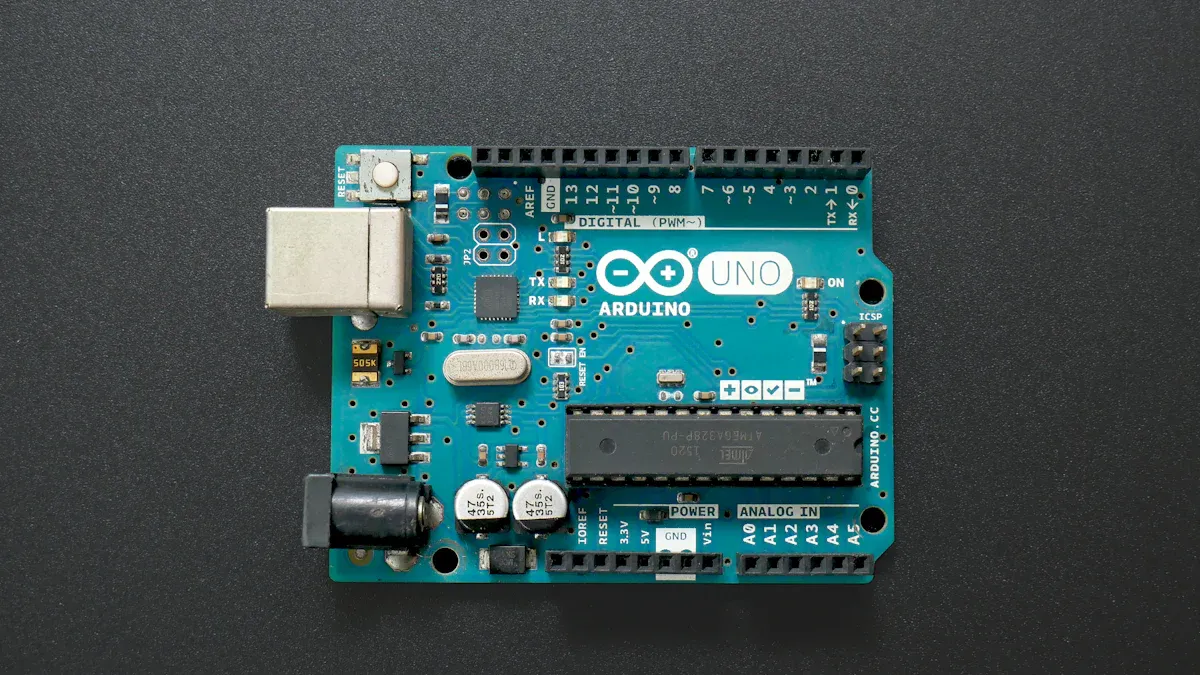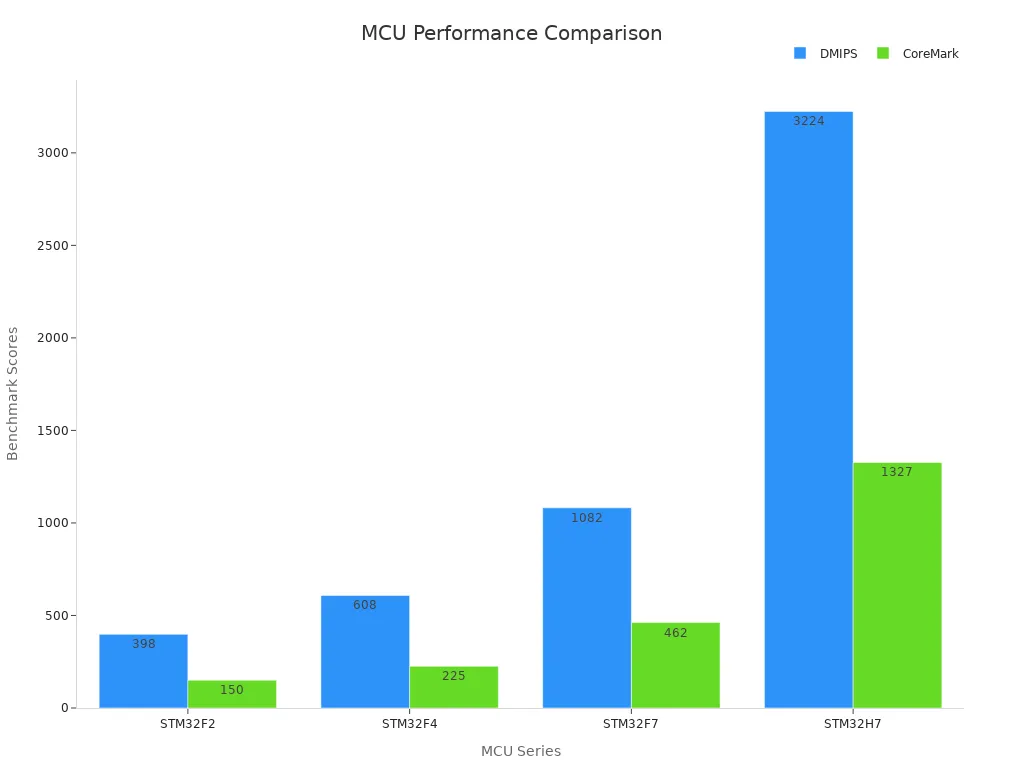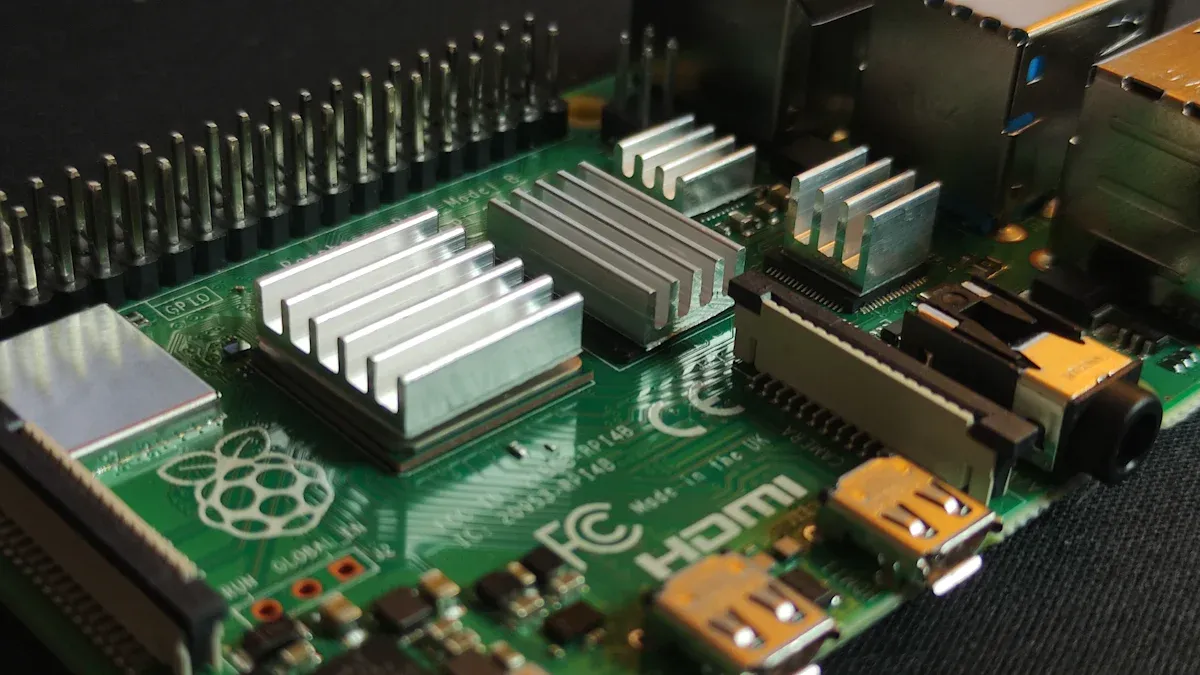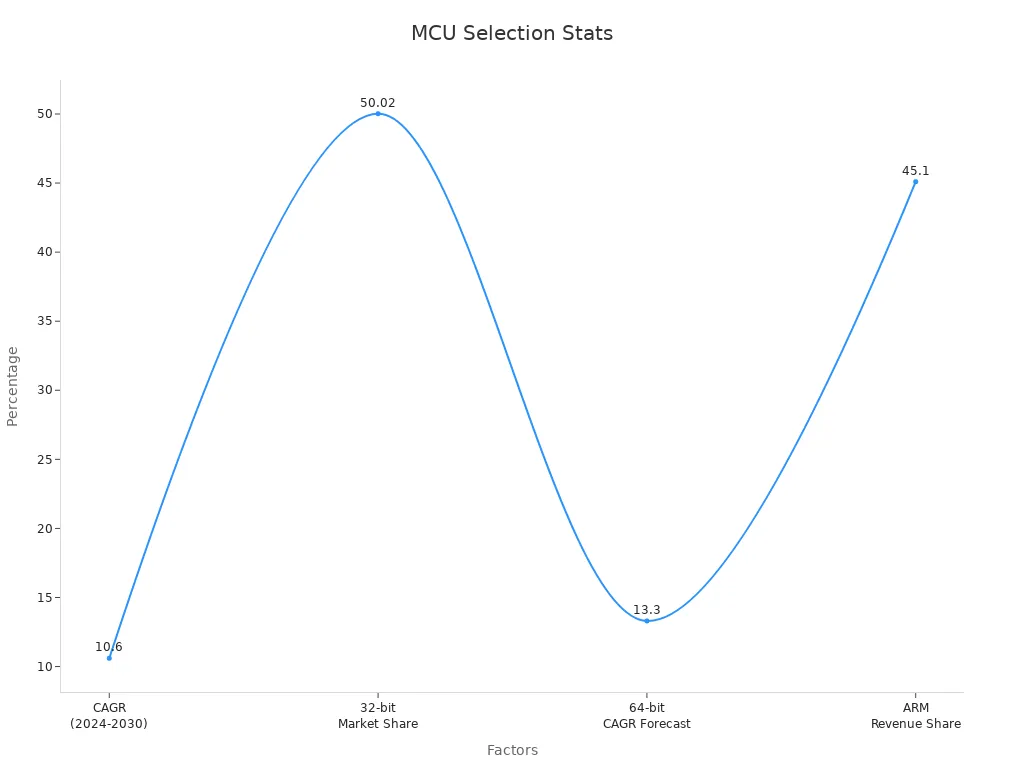What is an MCU Chip Microcontroller and How Does It Work

You can think of an MCU Chip Microcontroller as a tiny computer chip that controls devices like cars, medical monitors, and smart home gadgets. This small chip contains a processor, memory, and parts for handling inputs and outputs, all packed together. Many industries use these chips because they offer fast processing, low power use, and built-in features.
Key Feature | Value or Description |
|---|---|
Market Size (2024) | |
Largest Application | Automotive |
Top MCU Type | 32-bit (55% market share) |
An MCU Chip Microcontroller follows instructions from its program to receive information, process it, and control connected devices.
Key Takeaways
An MCU chip microcontroller is a small computer chip that controls devices by processing inputs and managing outputs quickly and efficiently.
Key parts of an MCU include a CPU for decision-making, memory for storing data, and input/output peripherals to connect with sensors and devices.
Modern MCUs offer extra features like hardware accelerators, power-saving modes, and security tools to make devices smarter, faster, and safer.
MCUs differ from general-purpose computers by focusing on specific tasks with low power use and real-time control, making them ideal for embedded systems.
Choosing the right MCU depends on your project’s needs for power, memory, speed, and peripherals to ensure the best performance and cost-effectiveness.
Main Components of an MCU Chip Microcontroller

Understanding the main parts of an MCU Chip Microcontroller helps you see how it works inside your favorite devices. Each part has a special job that lets the chip process information, store data, and connect with the outside world.
Central Processing Unit (CPU)
The CPU acts as the brain of the microcontroller. You can think of it as the part that reads instructions and makes decisions. Over the years, CPUs in microcontrollers have become much faster. For example, in automotive systems, CPU performance has grown about 50 times since the 1980s. This huge jump means your devices can now handle more complex tasks and respond quickly.
Modern CPUs use powerful instruction sets and faster clock cycles. These improvements let the CPU do more work in less time. Benchmarks, like those from the Embedded Microprocessor Benchmark Consortium (EEMBC), help engineers measure how well a CPU performs. These tests focus on real-world tasks, such as those found in cars or industrial machines. As a result, you get reliable and efficient devices.
Tip: A faster CPU means your device can process more data and react to changes quickly.
Memory Types
Memory stores the data and instructions that the CPU needs. Different types of memory affect how fast and how much information your microcontroller can handle. You will find that memory comes in several forms, each with its own strengths.
MCU Type | Memory Bus Width | Performance Characteristics | Cost/Price Considerations |
|---|---|---|---|
8-bit | 8-bit external bus | Limited precision; needs extra steps for complex math, which slows things down | Uses cheaper memory; less expensive but can be a bottleneck |
16-bit | 16-bit internal bus | Better than 8-bit but still slower than 32-bit; may still need extra steps for some tasks | Slightly more expensive than 8-bit |
32-bit | 32-bit internal bus; cache controller enables use of 8-bit external memory | Fast and accurate; handles complex math in one step; great for advanced tasks like digital signal processing | Cache controller allows use of cheaper memory; price difference with 16-bit often small |
You can see that 32-bit microcontrollers offer the best performance for demanding applications. They process data faster and more accurately. However, 8-bit and 16-bit types still work well for simple tasks and cost less.
Input and Output Peripherals
Input and output peripherals let your MCU Chip Microcontroller talk to the outside world. Inputs gather information from sensors or buttons, while outputs control things like lights, motors, or displays. You will find many types of interfaces, such as SPI, I2C, and UART. These interfaces help your microcontroller connect with other chips and devices.
Some microcontrollers, like the LIS331EB sensor hub, include an ARM Cortex-M0 core and support multiple power modes. This means you can save energy when your device does not need to work at full speed. Peripherals also include analog-to-digital converters, timers, and communication ports. These features make your microcontroller flexible and ready for many different jobs.
Development boards often list technical specifications for these peripherals. This helps you pick the right board for your project.
IoT devices need microcontrollers with the right mix of memory, interfaces, and power-saving features.
Gateway devices use more powerful microcontrollers to handle many communication protocols and keep your data secure.
Note: Choosing the right peripherals ensures your device can sense, communicate, and control as needed.
Additional Integrated Features
When you look inside a modern MCU Chip Microcontroller, you find more than just a CPU, memory, and basic input/output. Manufacturers add extra features to help you solve complex problems, save energy, and keep your data safe. These integrated features make your devices smarter and more efficient.
Hardware Accelerators and Specialized Units
Many microcontrollers now include hardware accelerators. These parts help you process data faster by handling tasks like math calculations, digital signal processing (DSP), or floating-point operations. For example, the STM32F4 series uses a Floating Point Unit (FPU) and DSP instructions. This means you can run audio processing or sensor data analysis much quicker than with a basic CPU.
Advanced Memory Technologies
You also benefit from advanced memory systems. Some chips use special memory controllers or cache to speed up data access. The ART Accelerator™ in the STM32 family lets you run programs from flash memory at high speeds. This helps your device respond quickly, even when working with large programs.
Power Management Features
Saving energy is important, especially in battery-powered devices. Many microcontrollers offer multiple power modes. You can put your device to sleep when it is not busy, then wake it up fast when needed. The STM32F0 series, for example, can drop to just 1 µA in low power mode. This helps you build products that last longer on a single charge.
Security and Safety Enhancements
Security matters more than ever. Some microcontrollers include cryptographic accelerators and isolation features like TrustZone®. These tools help you protect sensitive data and keep your device safe from attacks. The STM32H7RS series adds even more security, supporting advanced encryption and secure boot features. You can trust these chips in medical, industrial, and IoT applications.
Flexible Connectivity and Multimedia
You often need to connect your device to other systems. Integrated features like USB, CAN, Ethernet, and wireless support make this easy. Some chips even include image signal processors or neural network accelerators. The STM32N6 series, for example, targets edge AI applications with a Neural-ART accelerator and multimedia support.
Tip: Choosing a microcontroller with the right mix of integrated features helps you meet your project’s needs without adding extra chips or increasing costs.
Performance Comparison Table
You can see how these features boost performance by looking at benchmark scores and integrated technologies:
MCU Series | Core Type | Max Clock Speed (MHz) | Memory (Flash / RAM) | Power Consumption | Benchmark Scores (DMIPS / CoreMark) | Integrated Features and Benefits |
|---|---|---|---|---|---|---|
STM32F4 | ARM Cortex-M4 | 180 | Up to 1 MB Flash | Medium | 225 DMIPS / 608 CoreMark | FPU, DSP instructions, ART Accelerator™ |
STM32F2 | ARM Cortex-M3 | 120 | Up to 1 MB Flash | Low (175 µA/MHz) | 150 DMIPS / 398 CoreMark | Advanced NVM process, ART Accelerator™ |
STM32F7 | ARM Cortex-M7 | 216 | Larger Flash and RAM | Medium | 462 DMIPS / 1082 CoreMark | L1 cache, ART Accelerator™ |
STM32H7 | ARM Cortex-M7 | N/A | Large Flash and RAM | N/A | 1327 DMIPS / 3224 CoreMark | High-performance NVM, embedded flash |
STM32F3 | ARM Cortex-M4 | 72 | Up to 256 KB Flash / 40 KB RAM | Medium | N/A | DSP instructions, FPU, versatile peripherals |
STM32F0 | ARM Cortex-M0 | 48 | 16 KB to 256 KB Flash / 4-32 KB RAM | Low (down to 1 µA in low power mode) | N/A | Cost-effective, low power, wide voltage range |
You notice that microcontrollers with more advanced features reach higher benchmark scores. This means your device can handle more demanding tasks.

Real-World Benefits
The STM32 high-performance platform uses advanced memory and accelerators to give you top system performance and flexibility. Security features like cryptographic accelerators and TrustZone® isolation help you build safe IoT, medical, and industrial devices. The STM32H7RS series goes even further, running up to 600 MHz and supporting external memory for tough jobs. These features let you create products that are powerful, secure, and energy efficient.
Note: Integrated features in an MCU Chip Microcontroller help you solve real-world problems with less effort and better results.
How an MCU Chip Microcontroller Operates
Understanding how an MCU Chip Microcontroller works helps you see why it powers so many devices around you. The chip follows a cycle: it receives inputs, processes instructions, and controls outputs. Each step happens quickly and with high efficiency.
Receiving and Processing Inputs
You start by giving the microcontroller information. This can come from sensors, buttons, or other electronic signals. The chip uses its input pins to collect these signals. Some microcontrollers use advanced circuits, like Floating Gate Multiple Input Translinear Elements (FG MITE), to handle these inputs. These circuits let the chip process several signals at once and perform complex math, such as addition or multiplication, using very little power.
The chip can also adapt to changes in the signals. It uses learning algorithms to adjust how it reads inputs, so it stays accurate even if the environment changes. This means your device can keep working well, even if the signals are not always the same. The chip’s design also reduces the need for extra parts, like analog-to-digital converters, which saves energy and space.
Tip: Efficient input processing lets your device react quickly and use less battery power.
Executing Program Instructions
Once the microcontroller receives input, it follows a set of instructions stored in its memory. You write these instructions as a program, which tells the chip what to do with the information it gets. The central processing unit (CPU) reads each instruction, one at a time, and carries out the required actions.
The CPU can make decisions, repeat tasks, or jump to different parts of the program based on the input data. For example, if a sensor detects a high temperature, the program might tell the chip to turn on a fan. The speed of the CPU and the size of its memory affect how fast and how much it can do at once.
You can also use special features, like hardware accelerators, to speed up certain tasks. These features help the chip handle complex jobs, such as digital signal processing, without slowing down the rest of the program.
Controlling Outputs
After processing the inputs and running the program, the microcontroller sends signals to control other devices. You might use it to turn on lights, move a motor, or display numbers on a screen. The chip uses output pins to send these signals.
Several built-in tools help the chip manage outputs with precision:
Efficiency Metric / Control Data | Description | Role in Managing Output Control Tasks |
|---|---|---|
Hardware counters with adjustable settings | Provide accurate timing and control for devices like motors or LEDs | |
Interrupts | Special signals that pause normal tasks | Allow the chip to respond quickly to important events |
Bit Size (8, 16, 32-bit) | Size of data chunks the chip handles | Larger sizes mean faster and more accurate control |
Clock Speed | How fast the chip runs | Higher speeds allow quicker responses and better timing |
I/O Ports | Physical pins for signals | Connect directly to devices for real-time control |
You can see that timers and counters help you create precise delays or control the speed of a motor. Interrupts let your device react instantly to changes, such as a button press. The bit size and clock speed affect how quickly and accurately the chip can manage outputs. I/O ports give you a direct link to the outside world, so your device can interact with sensors and actuators in real time.
Note: Direct connections between the chip and external devices make your system fast and reliable.
By following this cycle—receiving inputs, executing instructions, and controlling outputs—you can build devices that sense, decide, and act in the real world.
MCU Chip Microcontroller vs. General-Purpose Computers
Core Differences
You will notice some big differences between microcontrollers and general-purpose computers. Microcontrollers focus on doing one job very well, while general-purpose computers handle many tasks at once. Microcontrollers often use ARM or RISC-V cores, which are simpler than the x86 or advanced ARM cores found in laptops and desktops. You get tightly integrated peripherals like GPIO, ADC, timers, and communication ports right on the chip. This lets you connect sensors and control devices directly, without extra hardware.
Empirical benchmarks show that microcontrollers with special neural hardware can process tasks much faster and use less power than those without it. For example, the STM32H7A3ZI microcontroller uses about 55 mW of power and keeps latency low for simple models. In contrast, the ESP32 uses more power and has higher latency. Some RISC-V chips can process data in less than a millisecond, showing how different designs affect speed and efficiency. Idle power use also varies a lot. Some chips use as little as 10 mW, while others use over 100 mW. This means you can pick a microcontroller that matches your power needs.
Microcontrollers come in 8-bit, 16-bit, or 32-bit versions. Higher bit sizes mean faster and more complex processing.
You find specialized peripherals for things like automotive, AI, or cryptography, which are not common in general-purpose computers.
Microcontrollers use Harvard architecture for parallel operations, while general-purpose computers use Von Neumann architecture.
Manufacturers design microcontrollers for specific jobs, so you get low power use and real-time control.
General-purpose computers focus on multitasking and high performance for many applications.
Note: Microcontrollers give you real-time control and low power use, while general-purpose computers offer more memory and multitasking.
When to Use an MCU Chip Microcontroller
You should choose a microcontroller when your project needs fast response, low power, and simple control. Microcontrollers work best in devices that must react quickly, run on batteries, or cost very little. You see them in things like smart thermostats, car sensors, and fitness trackers.
Here is a table to help you decide:
Decision Factor | MCU Microcontroller Characteristics | General-Purpose Computer Characteristics |
|---|---|---|
Real-Time Operation | Guaranteed worst-case response time; periodic task execution | Not guaranteed; general-purpose OS scheduling |
Memory Size | Typically thousands to millions of bytes | Typically billions of bytes |
Power Consumption | Low power, suitable for battery-operated devices | Higher power consumption |
Cost | Low cost, suitable for high-volume disposable products | Higher cost |
Architecture | Harvard architecture with multiple buses for parallel ops | Von Neumann architecture with single bus |
Performance Focus | Optimized for specific embedded tasks with real-time needs | General-purpose, optimized for diverse applications |
If you need a device to run for months on a small battery, or you want to control hardware directly, a microcontroller is the right choice. If you need lots of memory, multitasking, or complex software, a general-purpose computer works better.
Features and Applications of MCU Chip Microcontroller

Common Features
You will find that most microcontrollers share a set of important features. These features help you build devices that are smart, reliable, and easy to control.
Low Power Consumption: Many microcontrollers use very little energy. You can run them on batteries for a long time.
Integrated Peripherals: You get built-in timers, analog-to-digital converters, and communication ports. These let you connect sensors, motors, and displays without extra parts.
Flash Memory: You can store your program and data directly on the chip. This makes updates and changes simple.
Multiple I/O Pins: You have many pins to connect buttons, LEDs, or other devices.
Real-Time Operation: Microcontrollers respond quickly to changes. You can use them in systems that need fast reactions.
Tip: When you choose a microcontroller, look for features that match your project’s needs. Some chips offer extra security, wireless support, or special math functions.
Real-World Applications
You see microcontrollers in many devices around you every day. They help make products smarter and more useful.
Application Area | Example Devices | What the Microcontroller Does |
|---|---|---|
Home Automation | Smart thermostats, light switches | Controls temperature, lighting, and more |
Automotive | Airbags, engine control units | Monitors sensors and manages safety |
Healthcare | Blood glucose meters, monitors | Processes sensor data and displays info |
Consumer Electronics | Remote controls, toys | Handles user input and device actions |
Industrial | Factory robots, sensors | Automates machines and tracks data |
You can also find microcontrollers in wearable devices, such as fitness trackers and smartwatches. They help you track steps, measure heart rate, and send alerts. In agriculture, microcontrollers control irrigation systems and monitor soil moisture. These examples show how microcontrollers make technology work better in many fields.
Note: Microcontrollers help you solve real-world problems by making devices smarter and more efficient.
Choosing an MCU Chip Microcontroller
Key Selection Factors
When you choose a microcontroller, you need to look at several important factors. These help you find the best fit for your project and make sure your device works well and safely.
Power Consumption Benchmarks: You can compare how much energy different microcontrollers use by looking at figures like µW/MHz. Benchmarks such as Drystone or CoreMark show which chips save more power.
Safety Metrics: If your project needs high reliability, check diagnostic coverage and FIT (Failure In Time) rates. These numbers tell you how well a chip can detect and handle faults.
Built-in Safety Features: Look for features like watchdog timers, memory protection, error detection, and trusted zones. These help your device stay safe and meet standards like ISO 26262.
Certification: Some chips come with certificates from third-party labs. These show the chip meets safety rules for cars or factories.
Development Tools: Good software tools make it easier for you to write, test, and debug your code. Tools that meet safety standards add extra confidence.
Flexibility vs. Cost: Sometimes, you need to decide between a flexible microcontroller and a hardwired solution. Think about silicon area, power use, and cost for your project.
Here is a table with market data and trends that can guide your choice:
Factor/Segment | Data/Statistic | Explanation/Implication for MCU Selection |
|---|---|---|
U.S. Microcontroller Market Size (2023) | Shows strong market and many choices | |
CAGR (2024-2030) | 10.6% | Fast growth means more new features and options |
32-bit Microcontroller Market Share (2023) | 50.02% | Most popular for power and connectivity |
64-bit Microcontroller CAGR (Forecast) | 13.3% | Best for projects needing lots of data processing |
ARM Type Revenue Share (2023) | 45.1% | ARM chips lead in innovation and use |
Key Application Drivers | Smart meters, automotive, medical | Demand for low power, security, and integration |
Performance Considerations | Processing power, power use, security, integration | Key for matching chips to your needs |
Market Challenges | Failures in extreme conditions | Reliability matters for tough environments |
Trends | Miniaturization, wireless, security | New designs focus on small size and better connections |

Tip: Always match the chip’s features to your project’s needs. Do not pick a chip just because it is popular.
Matching MCU Chip Microcontroller to Your Project
You want your device to work well, so you need to match the microcontroller to your project’s requirements. Here are some things to check:
Processing power: Make sure the chip can handle your tasks. More complex projects need faster chips.
Memory size: Check if there is enough memory for your program and data, both now and in the future.
Power consumption: Pick a low-power chip for battery devices. Look for sleep modes and power-saving features.
I/O capabilities: Count the input and output pins you need. Make sure the chip has the right communication ports, like UART, SPI, or I2C.
Memory architecture and instruction set: Some chips use Harvard architecture or RISC instruction sets for better speed.
Development tool support: Choose a chip with good software tools and community help.
Cost: Think about the total cost, including the chip, tools, and how easy it is to scale up.
Lead times and availability: Make sure you can get the chip when you need it, both for testing and for making lots of devices.
Compatibility: Check if the chip works with your current hardware and software.
Industry fit: Some chips work best in certain fields. For example, STM32 is common in consumer electronics, NXP Kinetis in factories, Microchip PIC32 in medical devices, Infineon AURIX in cars, and Nordic nRF in IoT gadgets.
Note: When you match the right microcontroller to your project, you get better performance, lower costs, and a smoother design process.
You see MCU Chip Microcontroller technology shaping the world around you. These chips power cars, smart homes, and factories, offering fast processing and reliable control. Market trends show strong growth, especially in automotive, industrial automation, and IoT. Companies keep adding features like AI, better security, and wireless connections. As electronics manufacturing expands in Asia-Pacific and beyond, you can expect MCU Chip Microcontroller innovation to drive even more advanced devices in the future.
FAQ
What does MCU stand for?
MCU stands for Microcontroller Unit. You use it to describe a small computer chip that controls electronic devices. This chip combines a processor, memory, and input/output features in one package.
How do you program an MCU chip microcontroller?
You write code using a programming language like C or C++. Then, you upload the code to the chip with a special tool called a programmer or debugger. Many companies provide free software to help you get started.
Can you reuse an MCU chip microcontroller?
Yes, you can erase and reprogram most MCU chips many times. You just need to connect the chip to your computer and use the right tools. Some chips have limits on how many times you can rewrite them.
What is the difference between an MCU and a CPU?
The CPU is the brain inside a computer or microcontroller. An MCU includes a CPU plus memory and input/output parts. You use an MCU to control devices, while a CPU alone cannot do this without extra components.
Where do you find MCU chip microcontrollers in daily life?
You see MCU chips in many places:
Cars (airbags, sensors)
Home gadgets (thermostats, smart lights)
Medical devices (monitors)
Toys and remote controls
These chips help your devices work smarter and faster.
See Also
A Clear Guide To How Communication Chips Operate
An Introduction To Microcontrollers And Flash Memory Concepts
Exploring The Role And Operation Of Current Controller Chips
How System Monitor Chips Function And Their Key Purposes
The Functionality And Importance Of Power Supply Chips Explained
